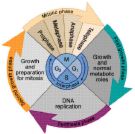Use of Oocytes in Cell Studies
Why Frog Oocytes Work
In studies of cell division, the frog oocyte, or egg, is particularly suited to the task. The oocytes do not reqire growth before they divide, they simply split apart because they are already so large. The cells split about thirteen times, and the entire process takes only about an hour. The cycle is very short and simple, perfect for manipulating or studying.
Frog Oocyte pictured to the right
Studies Using Frog Oocytes
Researchers used an African frog b/c its eggs can be seen by the naked eye and it can be tricked into making eggs. Oocytes do not need to grow before they divide. It divides about 15 times. It takes about half an hour for this process in this species, and is very simple. 1. Synthesis, in which the cells synthesize DNA 2. Division in half (mitosis). The objective of the experiment was to find a factor that would cause the cell to start dividing (factors are purified components). These oocytes are easily injectable, and there is no transcription, so there are no gene expression changes.
Masui's Studies
Dr. Masui found a specific gluten which, when reduced, created a maturation promoting factor, or MPF. This, when injected into the oocytes, caused the cell to divide rapidly and thus more effectively. Masui worked with sea urchin oocytes for the same reasons as stated for the frog oocytes. This experiment is elaborated on in the next page section.

